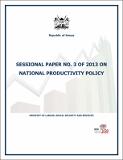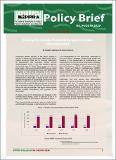Discussion Paper No. 17 of 2002 on Performance of Kenya's Wheat Industry and Prospects for Regional Trade in Wheat Products
Publication Date
2002Author
Type
KIPPRA Publicationsviews
downloads
Metadata
Show full item recordBy
Nyangito, Hezron; Ikiara, Moses & Ronge, Eric
Abstract/
Wheat is the second most important food crop in Kenya. Wheat production has however declined over the years due to high production costs, high capital costs, lack of credit for production, and the low level of technology-adoption in wheat production. Kenya has had to rely on wheat imports to meet the domestic and regional demand for wheat and wheat products. Increased wheat imports have led to a further decline in wheat production because imports dampen domestic prices, which is a disincentive to production. Kenya’s exports of wheat products have also faced increased competition because of the high cost of domestic wheat. These factors combined could lead to collapse of the domestic manufacturing industry and consequently loss of employment and livelihood of many Kenyans. This study reviews the constraints faced by the wheat industry in Kenya and proposes policy options that can be considered in developing the wheat industry. Although Kenya does not have a comparative advantage in wheat production, the country benefits from regional trade in wheat products. However, since the country faces competition from other countries, there is need to relax the constraints in wheat production, manufacturing of wheat products, and in marketing of wheat products in the domestic and regional markets. Research, extension, credit and marketing functions need to be adequately funded in order to encourage increased domestic production of wheat. Import taxes and duties on wheat imports should be eliminated to avoid protecting inefficient producers. Input supply and output marketing needs to be made competitive through provision of improved infrastructure services. There is also need for better management of policy on wheat imports and trade to avoid distortions in the wheat market. Finally, wheat farmers and manufacturers of wheat products need to be provided with information regarding regional market conditions.
Publisher
The Kenya Institute for Public Policy Research and Analysis (KIPPRA)Series
DP/17/2002;Collections
- Discussion Papers [344]
Related items
Showing items related by title, author, creator and subject.
-
Sessional Paper No. 03 of 2013 on National Productivity Policy
Ministry of Labour, Social Security and Services (Ministry of Labour, Social Security and Services, 2013)This Sessional Paper on National Productivity Policy presents the paradigm shift required for productivity management in the country. It contains specific and targeted interventions, which when effectively implemented, ... -
Garissa County Fiscal strategy Paper 2020
County Government of Garissa (County Government of Garissa, 2020)The Garissa County Fiscal Strategy Paper (CFSP) 2020 was prepared in accordance with section 117(1) of the Public Finance Management Act, 2012, which stipulates that the County Treasury shall prepare the Fiscal Strategy ... -
Policy Brief No. 94 of 2019-2020 on Closing the Gender Productivity Gap in Kenya's Informal Sector
Agwaya, Rodgers & Mairura, Shelvin (The Kenya Institute for Public Policy Research and Analysis (KIPPRA), 2019)Advancing gender equality in the labour market is critical to enhancing productivity. Historically, labour market structures have led to unequal distribution of opportunities and resources, leaving women disadvantaged, ...



